Blackburn and Darwen WwTWs (2018)
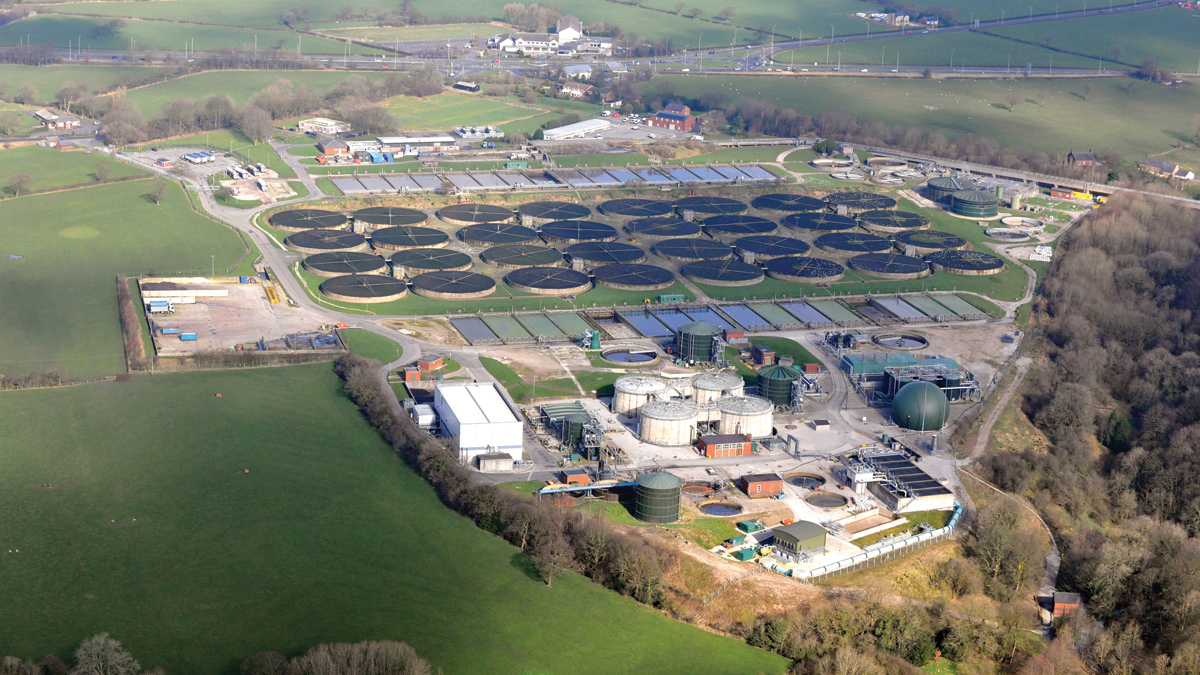
Blackburn WwTW - Courtesy of Airviews Photography & Co
Following on from the Blackburn and Darwen WwTWs (2017) article, the site at Samlesbury, Blackburn, has been prepared for the construction of the 72,000m3 structure which will house the innovative Nereda® aerobic granular biomass technology. The Nereda® system will treat crude sewage that has only received preliminary treatment and has been developed to treat the full flow and peak load at the works i.e. a complete replacement and expansion of the existing wastewater treatment plant with a new total capacity of approximately 400,000 PE.
Undertakings
LiMA, a joint venture between Laing O’Rourke and Atkins, one of United Utilities AMP6 Construction Delivery Partners, was appointed in December as main contractor for the following works collectively known as the Blackburn Batch:
- Blackburn Wastewater Treatment Works.
- Darwen Wastewater Treatment Works.
- Darwen Pipeline.
- Nabs Head Inlet Works.
Both Blackburn WwTW and Darwen WwTW discharge final and storm effluent to watercourses that are tributaries of the River Darwen, feeding into the River Ribble and ultimately impacting on the bathing waters of the Fylde coast. The above four elements will address the AMP6 and AMP7 requirements to improve the river and bathing water quality. The project will be completed in 2021.
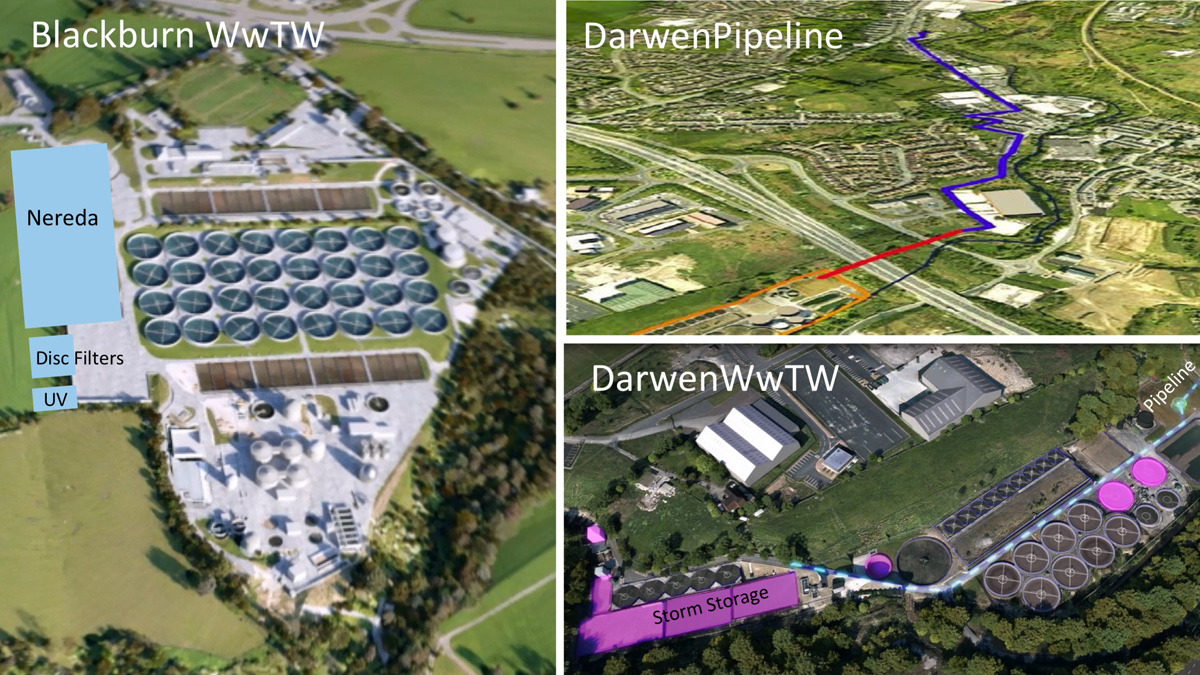
Blackburn Batch: Proposed layouts – Courtesy of United Utilities
Blackburn WwTW
The works was built in the 1960s comprising primary settlement tanks, trickling filters and humus tanks. More recent additions have been a tertiary BAFF and UV treatment and a dedicated pre-treatment plant for the adjacent AB InBev Brewery. It also has a sludge processing plant with import facilities, sludge thickening, enhanced enzymic hydrolysis pre-treatment, anaerobic digestion and centrifuge dewatering, prior to cake storage and recycling.
The existing site is fully developed and constrained on three sides (by roads and a river), however, when Blackburn Borough purchased the land in the 1960s they had the foresight to purchase the adjacent fields with expansion of the works being envisaged at some stage. This avoided the need to purchase additional land, however, not all of the land could be developed due to location of a strategic clean water aqueduct, which dictated either a small footprint solution or the sequential construction of the new works.
The works treats principally domestic crude sewage from the Blackburn catchment, with two major additional contributions; a high strength trade effluent from the brewery and an ammonia rich return liquor flow from the sludge treatment plant. The key river water quality/water framework directive parameters within the revised environmental permit are the need to achieve a BOD of 7mg/l and Ammonia of 1mg/l both on a 95%ile basis.
Nereda technology
The Nereda Aerobic Granular Biomass Technology was developed by Royal Haskoning DHV in close collaboration with the Dutch water sector and the Delft University of Technology. Following the success of the first full-scale implementation in 2006, the Nereda technology is quickly becoming the international standard for aerobic wastewater treatment. More than 40 Nereda plants are currently in operation or contracted in Europe, Africa, Australia and Americas.
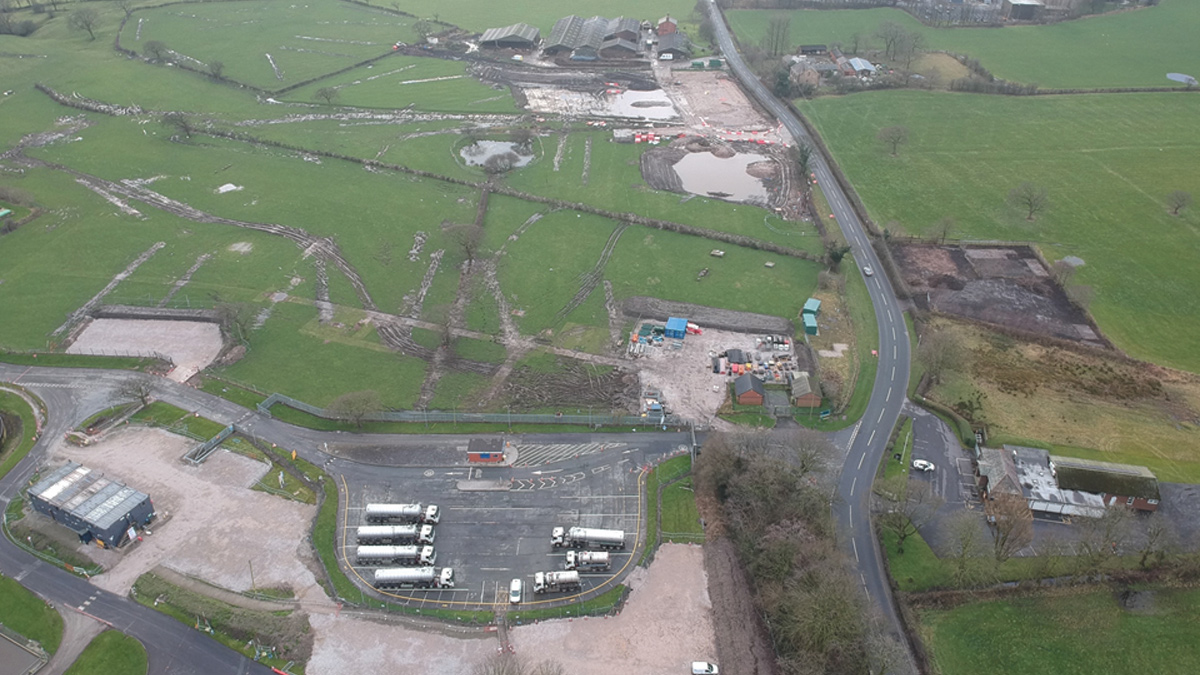
Location of Nereda® (foreground) and site cabins at Blackburn WwTW, scars in field from archaeology investigation – Courtesy of LiMA
Biomass in Nereda® develops as fast settling aerobic granular sludge which is a major advancement from the slow settling flocculent bio-sludge used in conventional BNR (biological nutrient removal activated sludge) systems. Due to high design biomass concentrations (8-15g/l) and high sludge settling velocities, the required bioreactor volumes are smaller. In addition, sludge settling and enhanced biological nutrient removal is performed in the same reactor and there is therefore no need for secondary clarifiers and anaerobic/anoxic tanks. This makes the system even more compact and significantly reduces the required footprint.
Outline design
The following starting points were used as the basis for the outline design:
- Biomass concentration (MLSS): Due to the excellent settling characteristics of aerobic granules, a relatively high MLSS concentration can be maintained in the reactor. When fully mixed (i.e. during aeration) an average biological MLSS concentration of 8g/l and above can be maintained.
- Sludge loading rate (F/M): Like activated sludge system design, the sludge loading rate (sludge age) is a key design parameter and is dependent mainly on the influent concentrations and effluent targets at the design temperature. Since the biomass composition (in terms of type of bacteria) in Nereda® systems is similar to activated sludge, the sludge loading rates for Nereda® designs are also similar. An average F/M (based on aeration time) of 0.06 kgBOD5/(kg MLSS.d) was applied.
- Reactor geometry: Given the excellent settling characteristics of the granular sludge, any reactor height above 5.5m is possible for the Nereda® system. Additional design considerations include hydraulics, energy efficiency of aeration and footprint limitations. A reactor water depth of 6.9m (process depth) has been selected.
- Sludge production: An average specific sludge production of 0.85gDS/g BOD5 removed has been applied.
- Tertiary solids removal and effluent quality: Tertiary solids removal is required to meet the 7mgBOD5/l consent. Depending on wastewater characteristics and applied pre or primary treatment, the average TSS in concentration in the Nereda® effluent is typically in the range of 10 to 15 mg/l. A typical 95%ile TSS concentration of 30 mgTSS/l can be applied for the design of the downstream tertiary solids treatment. Effluent BOD5 concentrations off Nereda® are typically in the range of 6-12mgBOD5/l and a 95%ile BOD5 concentration of 20 mgBOD5/l can be applied for the design of the downstream tertiary solids removal.
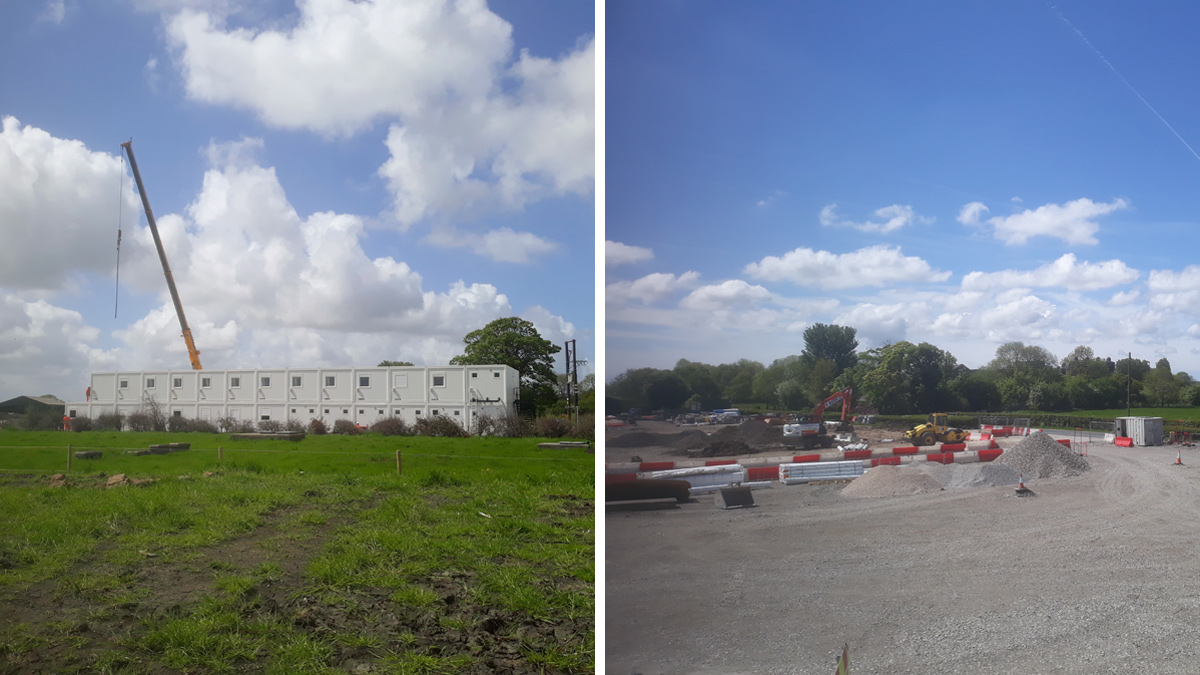
(left) Site cabins and (right) the site compound at Blackburn WwTW – Courtesy of United Utilities
Design considerations
To select cycle times and the required number of reactors the following considerations are of importance for design:
- The fill time should preferably be in the range of 0.6-2.0 hr.
- Increasing the length of the aeration phase reduces the required aeration capacity and the reactor volume since a larger fraction of the total cycle time is available for the aeration phase.
- The time required for settling and sludge decanting.
Based on the provided design basis, an outline design was developed comprising:
- 6 (No.) 12,000m3 Nereda® reactors.
- 2 (N0.) 800m3 Nereda® sludge buffers.
- 1 (No.) 800m3 Nereda® water level correction buffer.
- Associated pumping and aeration equipment.
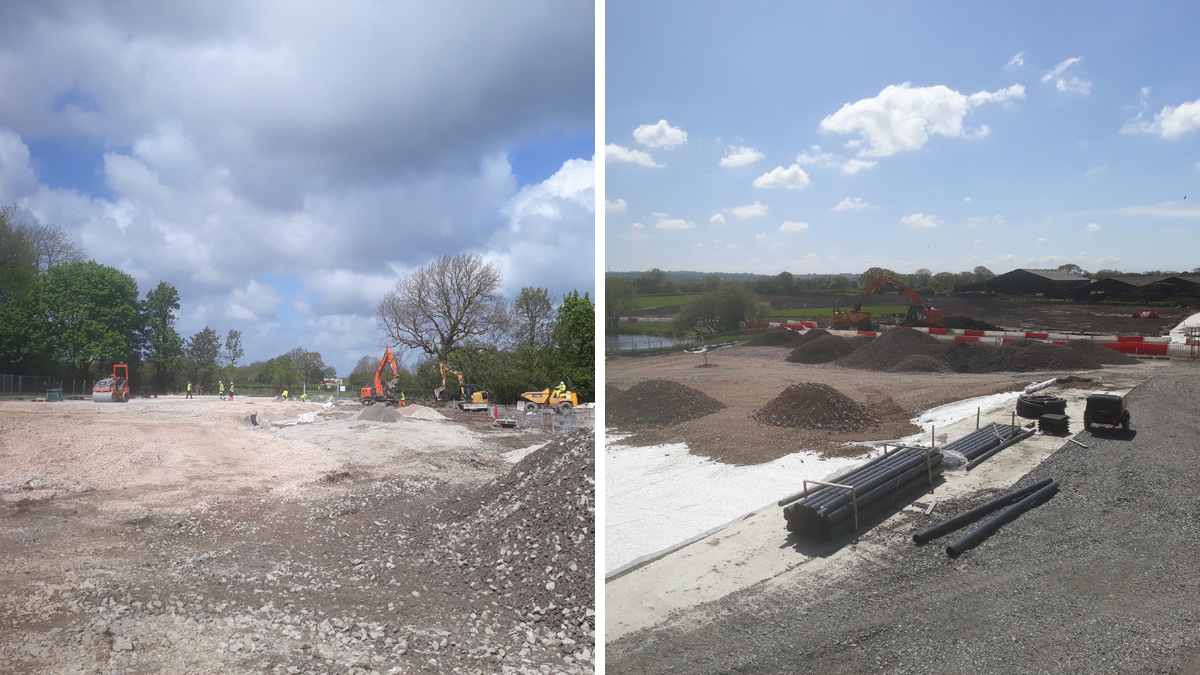
(left) Site entrance and (right) site compound at Blackburn WwTW – Courtesy of United Utilities
Pile cloth media filters
To achieve compliance with the revised BOD consent it was identified that tertiary treatment would be required. The treatment selected was a pile cloth media filters (PCMF) for the removal of suspended solid particles. The filter comprises of a series of very fine fibres, only microns in diameter, which are woven into a filter cloth which is less than 10mm in depth.
Suspended solids are removed from the water as it flows through the filter cloth, the solids being retained on the filter cloth. With increasing solids build-up on the filter cloth, the hydraulic resistance across the filter unit and thus the water level in the filter tank increases and a filter cleaning process is initiated.
The selected supplier was Mecana pile cloth media filters which offered compact, efficient tertiary treatment for the removal of solids, with ultra-low power consumption and are able to continue filtering full flow even during backwash.
A new UV disinfection system will also be provided for the WwTW upgrade, designed to treat the final effluent prior to discharge and meeting the requirements of the Bathing Water Directive. The treatment system will be selected based on a site specific dose response and validated UV equipment in accordance with the latest UU Standard(s), replacing the maximum applied dose system installed in AMP5. The supplier is yet to be selected.
Darwen WwTW
Like Blackburn the works was built in the 1960s and comprises inlet works, primary settlement tanks, trickling filters and humus tanks. A new energy intensive treatment process would be required to achieve the treatment element of the Water Framework Directive (WFD) driver and therefore the lowest cost solution identified was to abandon the works and transfer flows under gravity into the adjacent Blackburn drainage catchment and ultimately receiving treatment at the new Blackburn WwTW.
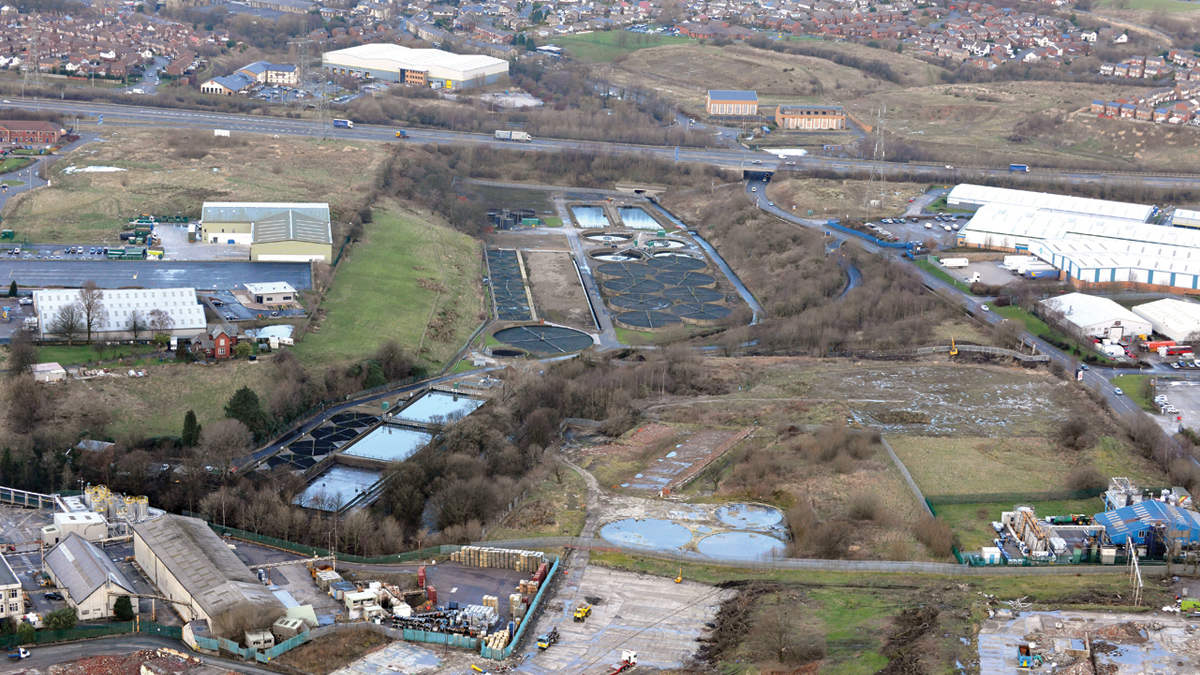
Darwen WwTW – Courtesy of Airviews Photography & Co
The second WFD element at Darwen WwTW required the reduction of intermittent discharges by increasing the volume of stormwater storage, to meet the required river water quality (FIS/RE 99%ile) standards. The contractor identified that the most economical way this could be achieved was by the refurbishment and conversion of what would become redundant primary settlement and humus tanks to provide an additional 4,750m3 of storm storage facilities.
There was also an Urban Wastewater Treatment Directive driver to achieve a 2mg/l phosphorus discharge level by November 2018, which will be achieved with the installation a temporary ferric dosing installation.
Darwen pipeline
This will initially pass underneath the M65 motorway in a tunnel before reverting back to a traditional gravity sewer construction as it passes between a residential development and a river and along Branch Road. The solution submitted at the tender stage was for a 1.6km pipeline of 700mm diameter.
Network modelling work is being undertaken to confirm the storm water storage requirements and ensure that flows diverted from Darwen into the Blackburn catchment cause no ‘level of service’ issues in the existing sewer network.
Nabs Head inlet works
Nabs Head was the location of Blackburn’s original sewage farm constructed in the 1890s and when the new works was constructed at Samlesbury in the 1960s the original humus tanks were converted to storm tanks, 9,400m3 capacity. The inlet works was moved back to Nabs Head in the early 1990s and comprise of screening and grit removal with an additional 10,700m3 of storm storage constructed in AMP5. To meet the Bathing Water Quality requirements the solution increases the flow to full treatment (FTFT) to 2,700 l/s from 1,800 l/s as well providing another 39,100m3 of stormwater storage.
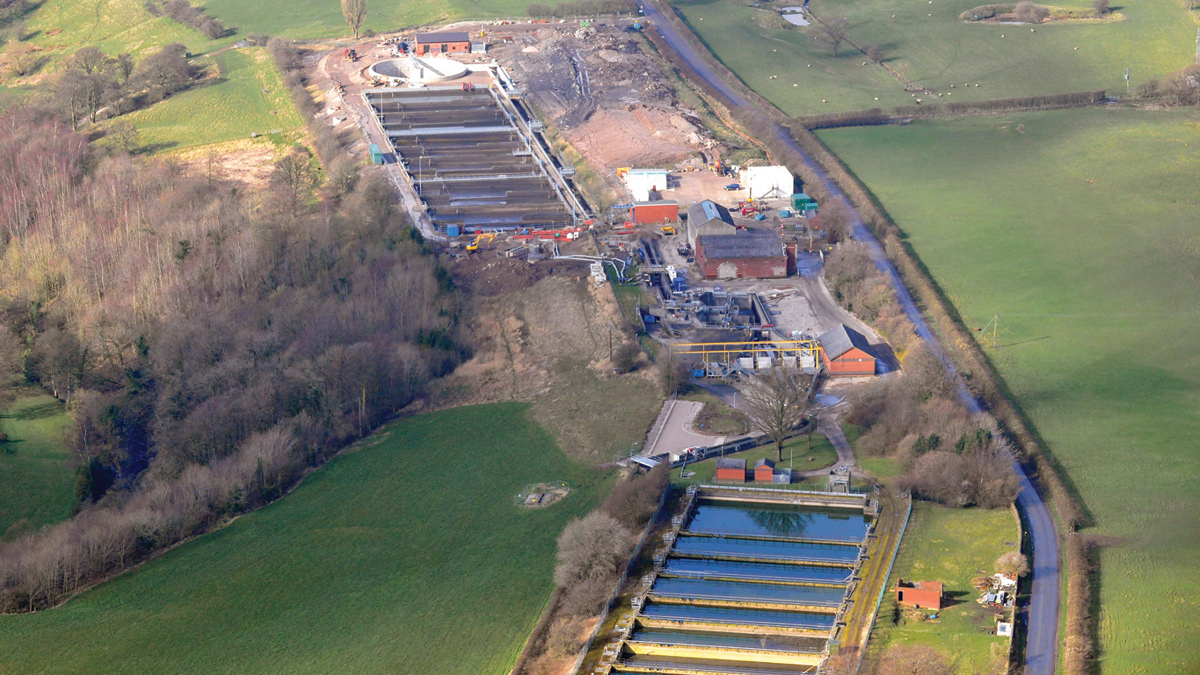
Nabs Head Inlet Works – Courtesy of Airviews Photography & Co
Conclusion
At the time of writing (May 2018), LiMA are carrying out the detailed design, which is scheduled to be significantly complete by December 2018. Ongoing enabling works include the construction of a new permanent entrance to the Blackburn WwTW as well as a temporary entrance for construction traffic. The major 180m x 60m x 8m deep excavation for the Nereda® reactors is programmed to commence in August 2018. The project will be completed in 2021 and it is anticipated that United Utilities and LiMA will jointly provide articles highlighting the detail design and construction of this project in future issues of UK Water Projects.












